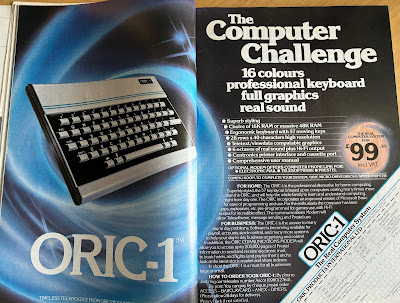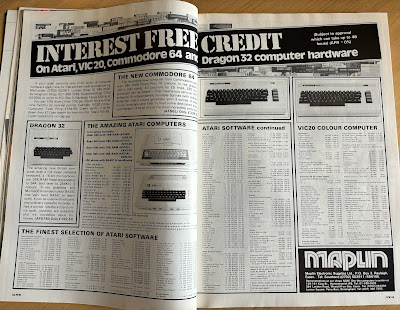42. A simple number. Possibly the answer to something. But also the number of years since this issue of Personal Computer World was published and, gentle reader, the past was a very different country. And that's before we get to the cover star of this issue, Digital's Rainbow.
Guy Kewney kicks us off with the news, and it's smiles all round as Acorn seem to have banished their backlog of BBC Micro orders. Huzzah, tea, biscuits, and all that jazz. Then you read what Mr Kewney has actually written and he is bitingly caustic at the shambles Acorn have been responsible for. New ROM versions that cause incompatibilities and unhappy user groups are just two of the headaches Acorn are now dealing with and there is very much a sense of "I told you so" emanating from the pen of the news desk. Sinclair are in fighting form trying to get their wares in to Primary schools, there is news of a new machine called the Oric, there is some confusion as to the nature of the then-unreleased but much promised Sinclair Microdrive, and what can only be described as "you couldn't make this up" reporting on Osborne.
There are more new machines coming to market - Camputer's Lynx promises another 8-bit wonder, while Espon's HX20 is the portable computer that did. Regular readers will know my affection for the much later Amstrad NC100 (as well as the Alphasmart 3000 and Cambridge Z88), so I really want someone to bring the form factor into the 2020's, and I do not mean the over-priced Freewrite Alpha.
Once past the latest happenings, Peter Rodwell ponders developments in the growing fight between MS-DOS and CP/M, whilst Martin Banks regales with tales of predictions in the computer industry and why he is wary to make his own. There's some interesting stuff here. The description of Clive Sinclair launching the Spectrum in the US - "Clive was a man with a reputation, to the US financial men, for a flair in design and danger in manufacturing" is brilliantly apt, and comments on Apple and Commodore are equally illuminating. The former has coasted for too long on the Apple II, the III isn't cutting the mustard and although it has a fantastic international distribution set up, if the company falters, it could be the target for a Japanese takeover - remember that back then, the Japanese were considered the competitors to beat when it came to microelectronics. As for Commodore, its issue was that it didn't have that great of a US base - it's European operations were bankrolling the operation. Once again, a potential Japanese offer could see the company off. Mr Banks closes with the statement that the apparent leaders of the personal computer market in the future would be IBM and DEC. As predictions go, that seemed likely at that point in time, but the advent of the 68000-powered Mac and Amiga would delay any collapse of either Apple or Commodore (but both would suffer for a variety of reasons as they entered the 90's), and the advent of the "clone" IBM compatible would topple the idea that the hardware producing companies mattered.
There is a report on the 5th PCW show, and very period it looks too. With 47,000 attendees, it was another smashing success and featured 210 exhibitors. Although Apple wasn't there, both Sinclair and Acorn had set up "villages", DEC had their Rainbow (see below for the preview), Professional and DECmate II, Commodore were showing off their new "64", and Jupiter and Camputers were proud their Ace and Lynx respectively. It was a profitable show too: Dragon claimed 275 sales of the Dragon 32 machine, and NewBrain dished out a similar amount.
Given the current fashion for all things A.I., the feature on using Artificial Intelligence to cheat your way out of algebra homework feels more than a little quaint, but at least there is a type in listing to get you started.
Canon provide the first hardware test for this issue with their CX-1, and it's a behemoth! Coming in at 55lbs(!), it would take up a fair amount of desk space and a disproportionate amount of your bank balance. Initially launching at £4,500, it was, by now, a tad more sensibly priced at just £2,500. That's alright then. An all-in-one with a 12-inch green on black monitor and dual floppy drives, the unit measures 64cm x 53cm x 33cm. There's no real graphics mode for the Canon, and although the display can handle 80 columns by 24 lines, the bottom two lines are used for the command display area. The two disk drives are 320k capacity and there are storage expansion options, with external 8-inch floppies and a 30Mb hard drive option. A Motorola 6809 running at 4MHz offers only mediocre performance but this definitely feels like a case of steady as she goes. You can fit up to 128kb of RAM, 32kb of which is used by the system, and there's 4kb of ROM too. If you fancied getting into the Canon action, that two and a half grand did include the maximum memory allocation. Adding extras like CIS Cobol (£190) or UCSD Pascal (£400) would prevent the bank balance from recovering too much.
 |
| The just looks silly. |
DEC's Rainbow is up next, but only in a preview. Although the monitor looks small, it really is a 12-inch CRT just with a huge housing, and looking teensy on top of that massive base unit. The display can handle 80 columns with a hassle, and a software option can take you up to 132, but that's eyestrain territory for any length of time. There are, however, graphics modes - 320x240 with 16 colours, or 800x240 with four colours from a palette of eight. The disk storage is funky - there are two drives, each handling two floppies at a time. As each disk can hold 409.6kb, that's over 800kb per drive. Impressive for the time, as is the option for a 5Mb Winchester disk. Similarly impressive is the CPU set up - the Rainbow contains both a Z80 and an 8088. Both share the supplied 64kb of RAM, with expansions for 128 and 192kb, taking the maximum amount to 256kb. To control all of this is the hybrid operating system CP/M 86/80. All of this costs a pretty penny, and as you can guess, adding extras quickly takes the price into the stratosphere. Still, it would have done whatever you wanted it to do and it was cheaper than an IBM PC.
 |
| And still more functionality than a Freewrite Alpha. |
It's portable time with Hewlett Packard, its HP-75C comes under the gaze of Dick Pountain, and although it would not become "the ultimate status symbol among the technologically inclined", it was a supremely powerful portable computer at a price (£728) that took it out of means of many. With 16kb (expandable to 24kb) of RAM, 48kb of ROM and using magnetic cards for storage (1.3kb per card), it was another step closer to Pountain's ultimate goal of a "pocket sized personal database cum calculator cum word processor cum communications station". It just needed another couple of decades to really get there.
Screenplay takes a gander at the Acorn Atom's range of games - eight in total, the best of which seems to be the Acornsoft Games Pack II, and even that scores just slightly above average.
The In Store section provides a handy guide to the range of machines available to the potential purchaser - and my word there are a lot! Six(!) pages of ready-made computers, plus another page of single board offerings.
To the adverts now and, in a departure from the usual, just check these out.
 |
| There is a lot to digest here. |
 |
| 'Cos everyone loves a game of Mastermind, yeah? |
 |
| That 700-series has serious 70's vibe, but that 500-series vibe would make a comeback. |
 |
| Condescending, much? |
 |
| "Professional" keyboard... yeah, right! |
 |
| Well played, Sinclair, well played... |
 |
| Me thinks the Spectrum is writing un-cashable cheques here... |
 |
| Beeeeb! |
 |
| They did have the Advertising Standards Authority back then, surely? |
 |
| With very good reason, Newbrain, very good reason! |
 |
| This ad was buried towards the back of the mag - it feels like they didn't care even then. |
Phew! In 1982, it wasn't a question of finding a computer to buy, it was which one of the many to choose from. If you think the market looked crowded then, there was more to come, and of all of these formats, only the Spectrum, Commodore 64 and Beeb would see much success passed 1985. All the rest would be gone or retired for better specified alternatives. It was also the time of national computer retailers, and Laskeys promised to see you right:
Home users could also top up their software collection at Maplin, as well as 0% interest for computer hardware purchases. Mind you, credit would have been useful for the games too - £25 then is about £85 now!
Spectrum were another potential source of cool kit, but unlike Maplin, their headline prices excluded VAT, so they only appeared cheaper when they were actually pretty much par for the course. That is more than slightly odd considering the machines here were aimed at home users.
For actual business people, there were other options. Although advertising with a mugshot that would make a Stasi ID card blush with embarrassment is something we have moved on from since then...
 |
| Obviously Frank hasn't sold many computers recently... |
LSI were offering a combo machine that could be the only machine you'd need - a Z80 for CP/M and an 8088 for MS-DOS - for a price, you understand, and £2k plus in 1982 was proper folding money! But it was also British, when such things mattered...
And the same could be said for the British Micro MIMI802, priced at a cool £1,350 minus the monitor (from £132) and not actually the machine pictured (that is the MIMI 802G at £1,495. Even the address is suitably patriotic for those who cared for such things: Penfold Works, Imperial Way. Needless to say, it was just another Z80 CP/M-ish (OS/M actually) desktop that would go the way of the dodo soon enough.
 |
| What the actual??? |












That was a fun trip to the past!
ReplyDeleteI'm glad you enjoyed it!
Delete